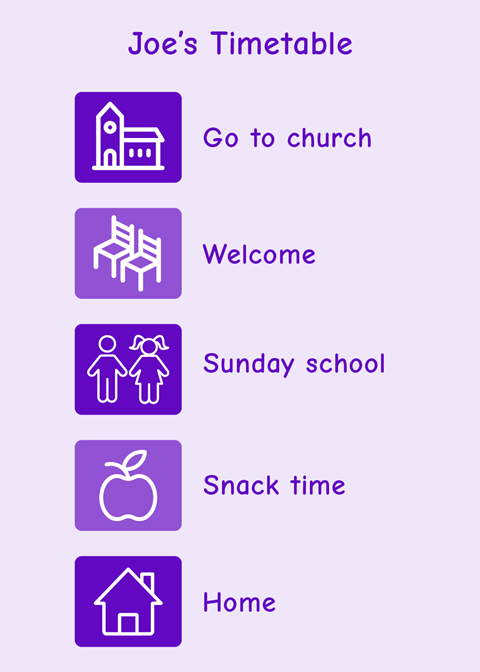Mark Arnold believes there are some simple steps you can take to make your church friendly for those with additional needs
As the return to children’s and youth work after the summer holidays gets closer for many of us, or has already started for some, it can be a time of great anxiety and stress for some children and young people, especially children and young people with additional needs. It can also be a challenging and difficult time for children’s and youth workers, as well as parents and carers too, so here’s 10 ‘Top Tips’, as well as some handy web links, that will equip us to help our children and young people return to their group well.

Ahead of the first day
-
Take anxiety and worries seriously. It’s easy to put their concerns off, or to convince ourselves that ‘they will be fine’, but the reality is that we could just be building up trouble for the first day if we put off taking their anxiety and worries seriously. By engaging with them about this early, it gives us more time to help and support them, and more time for them to process the support that we are providing for them.
-
Create a ‘social story’ about the return to children’s or youth work. Social stories can use images, symbols, as well as text, to help communicate new or complex things to children. A social story that tells them about their group, the team, and other children and young people they will meet, what they will be doing, all can help to prepare them for the first day.
An example of a social story (Going to Joy Club in Church) that can help is available at the bottom of the page.
As with all social stories, these should be adapted or used as a starting point to create a specific version for each child. More information about how to create social stories can be found on Lynn McCann’s Reachout ASC site here: https://www.reachoutasc.com/resources
-
Create a visual timetable for the first day, showing each stage of the session. A visual timetable helps children to know what is happening now, next, and later, what they need to do, and helps them to remain in control of what they are doing.
An example of a more complex visual timetable is shown below, although it could be as simple as two symbols or images just showing ‘now’ and ‘next’:

You can get more examples of visual timetables at: https://additionalneedsalliance.org.uk/information/
-
Arrange a visit to where the group meets ahead of the big day, if possible while it is quiet, to walk through the building, see the meeting place, maybe meet the leader, one-to-one helper, or other team members etc. Have a short, fun, activity ready to do.

On the first day
-
Try to suppress your own anxiety! It’s hard, but children and young people are very perceptive and can pick up when we’re stressed, making them even more anxious. In their minds, if we’re anxious, it must be really bad!
-
Get into a routine from day one. Try to run the first session how you mean to carry on. Have that visual timetable ready.
-
If possible, have them go to the group on the first day with a friend. Is there something they can take with them that will help them to regulate their anxiety, e.g. a fidget toy? (not something precious that might get lost!)
-
They are likely to be exhausted during and after the first session back.
- Children’s/ Youth Workers, take it easy on them and give them time to settle, don’t put pressure on them to always be engaging. Create a quiet space they can access if they are overwhelmed.
- Parents/carers, don’t bombard them with questions the moment you see them after their group session or expect too much straight away. Give them some down time first, maybe with a drink and a snack. Later, ask them what they enjoyed most about their group session today.
-
Let them do something they choose or want to do to afterwards to finish the day positively. They have had other people telling them what to do all day, so letting them choose what to do, or what to have for a meal for example, gives them some control back over their day.
-
Try to get them to bed early. They may be mentally and emotionally exhausted after the first day back at their group, especially if they were starting in a new age group with lots of change, and so an early night will be helpful if possible.
Useful links:
Twinkl
There’s a free download on the Twinkl website that helps explain returning to school which might also be helpful in the children’s/youth group context:
https://www.twinkl.co.uk/resource/returning-to-school-social-situation-t-s-2548814
You will also be able to link to other helpful resources from here.
Widgit
There are also free resources about returning to school on the Widgit website, which again might be helpful in a children’s/youth group context:
https://www.widgit.com/resources/popular-topics/back-to-school-june/index.htm
Makaton
There’s a free downloadable pack about going back to school on the Makaton website too (you’ll need to register but you can do this for free):
https://makaton.org/TMC/Free_resources_.aspx
Autism Little Learners
Just love this site, so full of useful stuff and there are some great social stories on this link:
https://autismlittlelearners.com/category/social-stories/
Use these website resources help you to stay informed and able to inform and support children and young people with additional needs as they return to their group. I hope these ‘Top Tips’ and website links are helpful for you as you navigate a path through the return to children’s and youth work with the children and young people you journey with.
Supporting documents
Click link to download and view these filesSocial story - Going to Joy Club in Church
Word, Size 7.97 mb












































